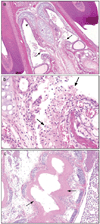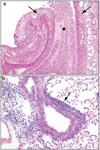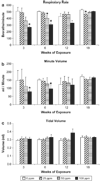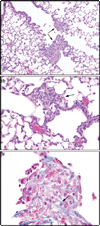Respiratory toxicity of diacetyl in C57BL/6 mice
- PMID: 18227102
- PMCID: PMC2669658
- DOI: 10.1093/toxsci/kfn016
Respiratory toxicity of diacetyl in C57BL/6 mice
Abstract
Diacetyl, a component of artificial butter flavoring, is a potential etiological agent of obliterative bronchiolitis (OB); however, the toxic dose and mechanisms of toxicity remain controversial. We evaluated the respiratory toxicity of diacetyl in a murine model using several exposure profiles relevant to workplace conditions at microwave popcorn packaging plants. Male C57Bl/6 mice were exposed to inhaled diacetyl across several concentrations and duration profiles, or by direct oropharyngeal aspiration. Effects of diacetyl on the respiratory tract were evaluated by histopathology and BALF analyses. Subacute exposure to 200 or 400 ppm diacetyl for 5 days caused deaths, necrotizing rhinitis, necrotizing laryngitis and bronchitis. Reducing the exposure to 1 h/day (100, 200, 400 ppm) for 4 weeks resulted in less nasal and laryngeal toxicity, but led to peribronchial and peribronchiolar lymphocytic inflammation. A similar pattern was observed with intermittent high-dose exposures at 1200 ppm (15 min, twice a day, 4 weeks). Subchronic exposures to 100 ppm (6 h/day, 12 weeks) caused moderate nasal injury, and peribronchial lymphocytic inflammation accompanied by epithelial atrophy, denudation, and regeneration. Treatment with 400 mg/kg by oropharyngeal aspiration to bypass the nose caused foci of fibrohistiocytic proliferation with little or no inflammation at the junction of the terminal bronchiole and alveolar duct. Depending on the route and duration of exposure, diacetyl causes significant epithelial injury, peribronchial lymphocytic inflammation, or fibrohistiocytic lesions in the terminal bronchioles. Collectively these results indicate that clinically relevant diacetyl exposures result in a pattern of injury that replicates features of human OB.
Figures







Comment in
-
Comments on respiratory toxicity of diacetyl [Re: Morgan, D. L., Flake, G. P., Kirby, P. J., and Palmer, S. M. (2008). Respiratory toxicity of diacetyl in C57Bl/6 mice. Toxicol. Sci. 103, 169-180].Toxicol Sci. 2008 Oct;105(2):429-32; author reply 433-4. doi: 10.1093/toxsci/kfn133. Epub 2008 Jul 3. Toxicol Sci. 2008. PMID: 18599497 No abstract available.
Similar articles
-
Necrosis of nasal and airway epithelium in rats inhaling vapors of artificial butter flavoring.Toxicol Appl Pharmacol. 2002 Dec 1;185(2):128-35. doi: 10.1006/taap.2002.9525. Toxicol Appl Pharmacol. 2002. PMID: 12490137
-
Popcorn worker's lung: in vitro exposure to diacetyl, an ingredient in microwave popcorn butter flavoring, increases reactivity to methacholine.Toxicol Appl Pharmacol. 2006 Aug 15;215(1):17-22. doi: 10.1016/j.taap.2006.02.001. Epub 2006 Mar 20. Toxicol Appl Pharmacol. 2006. PMID: 16545411
-
Respiratory toxicologic pathology of inhaled diacetyl in sprague-dawley rats.Toxicol Pathol. 2008 Feb;36(2):330-44. doi: 10.1177/0192623307312694. Epub 2008 Mar 5. Toxicol Pathol. 2008. PMID: 18474946
-
Flavorings-Related Lung Disease: A Brief Review and New Mechanistic Data.Toxicol Pathol. 2019 Dec;47(8):1012-1026. doi: 10.1177/0192623319879906. Epub 2019 Oct 23. Toxicol Pathol. 2019. PMID: 31645208 Review.
-
Diacetyl and 2,3-pentanedione exposures associated with cigarette smoking: implications for risk assessment of food and flavoring workers.Crit Rev Toxicol. 2014 May;44(5):420-35. doi: 10.3109/10408444.2014.882292. Epub 2014 Mar 17. Crit Rev Toxicol. 2014. PMID: 24635357 Review.
Cited by
-
The Impact of Device Settings, Use Patterns, and Flavorings on Carbonyl Emissions from Electronic Cigarettes.Int J Environ Res Public Health. 2020 Aug 5;17(16):5650. doi: 10.3390/ijerph17165650. Int J Environ Res Public Health. 2020. PMID: 32764435 Free PMC article.
-
New Approach Methods to Evaluate Health Risks of Air Pollutants: Critical Design Considerations for In Vitro Exposure Testing.Int J Environ Res Public Health. 2020 Mar 23;17(6):2124. doi: 10.3390/ijerph17062124. Int J Environ Res Public Health. 2020. PMID: 32210027 Free PMC article. Review.
-
Policy, toxicology and physicochemical considerations on the inhalation of high concentrations of food flavour.NPJ Sci Food. 2020 Oct 7;4:15. doi: 10.1038/s41538-020-00075-y. eCollection 2020. NPJ Sci Food. 2020. PMID: 33083547 Free PMC article. Review.
-
Inhalation dosimetry of diacetyl and butyric acid, two components of butter flavoring vapors.Toxicol Sci. 2009 Mar;108(1):173-83. doi: 10.1093/toxsci/kfn222. Epub 2008 Oct 21. Toxicol Sci. 2009. PMID: 18940962 Free PMC article.
-
Diacetyl/l-Xylulose Reductase Mediates Chemical Redox Cycling in Lung Epithelial Cells.Chem Res Toxicol. 2017 Jul 17;30(7):1406-1418. doi: 10.1021/acs.chemrestox.7b00052. Epub 2017 Jun 26. Chem Res Toxicol. 2017. PMID: 28595002 Free PMC article.
References
-
- Arora NS, Aldrich TK. Bronchiolitis obliterans from a burning automobile. South Med. J. 1980;73:507–510. - PubMed
-
- Barry BE, Miller FJ, Crapo JD. Effects of inhalation of 0.12 and 0.25 ppm ozone on the proximal alveolar region of juvenile and adult rats. Lab. Invest. 1985;53:692–704. - PubMed
-
- BASF. Study on the acute inhalation toxicity LC50 of diacetyl FCC as a vapor in rats, 4-h exposure. Ludwigshafen: FRG, BASF Aktiengesellschaft; 1993.
-
- Bradford MM. A rapid and sensitive method for the quantitation of microgram quantities of protein utilizing the principle of protein-dye binding. Anal. Biochem. 1976;72:248–254. - PubMed
Publication types
MeSH terms
Substances
Grants and funding
LinkOut - more resources
Full Text Sources
Miscellaneous

